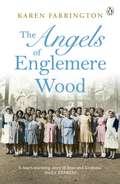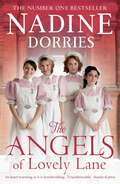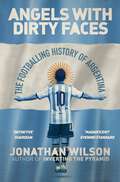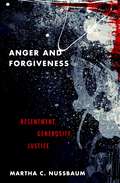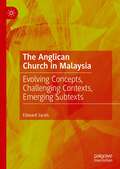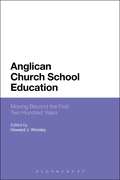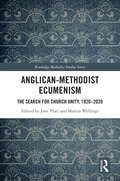- Table View
- List View
The Angels of Englemere Wood: The uplifting and inspiring true story of a children’s home during the Blitz
by Karen FarringtonThe inspiring, uplifting true story of a group of London girls dispatched to a children's home in rural England during the Blitz, and meet the formidable nurse and Lady in Waiting who transformed their lives forever . . .'An engaging war-time tale. These evocative first-person memories conjure a vivid picture of 1940s Britain, leaving a lasting impression' Lucy Fisher_______In the shadow of war, a twist of fate brings together the poor girls of a London children's home, a grieving Lady in Waiting, and a nurse who changes all their lives forever.In the gruelling years between the two world wars, Queenie Clapton's family struggled to stay afloat. With a father traumatised by the first gruesome conflict, only finding respite in local pubs, and a mother working night and day trying to keep food on the table, Queenie and her sister were swept up by the Waifs and Strays Society - a network of homes caring for thousands of children across the UK. As war broke out, waifs and strays like Queenie had no idea what the future would hold.Recently widowed, Lady Peyton knew her sons, both handsome and upstanding, would be heading to the front lines. Finding herself alone for the first time in her life, the Lady in Waiting decided to open the doors of her now unnervingly quiet stately home to the London children's home looking for shelter from the Blitz.Under the guidance of the formidable nurse Matron Bailey, young girls from the Waifs and Strays Society moved in with their high society hostess. Instead of a rattle of bombs, they heard birdsong. After enduring raw poverty, the girls now attended knitting circles with royalty. They were given a new lease on life, building a family under the toughest of circumstances and a sense of purpose and community that lasted generations.This is the inspiring true story of that remarkable bond forged in times of trouble, and the women at the heart of it all.
The Angels of Lovely Lane (The Lovely Lane Series #1)
by Nadine DorriesAs heart-warming as it is heartbreaking, this novel is unputdownable' Sunday Express. It is 1953 and five very different girls are arriving at the nurses' home in Lovely Lane, Liverpool, to start their training at St Angelus Hospital. Dana has escaped from her family farm on the west coast of Ireland. Victoria is running away from a debt-ridden aristocratic background. Beth is an army brat and throws her lot in with bitchy Celia Forsyth. And Pammy has come from quite the wrong side of the tracks in Liverpool. The world in which they now find themselves is complicated and hierarchical, with rules that must be obeyed. Everyone has their place at St Angelus and woe betide anyone who strays from it. But when an unknown girl is admitted, after a botched late abortion in a backstreet kitchen, a tragedy begins to unfold which will rock the world of St Angelus to its foundations. Can't wait for the next one? THE CHILDREN OF LOVELY LANE is out now! What people are saying about THE ANGELS OF LOVELY LANE: 'Nadine Dorries's writing is sparkling and vibrant, her books are a joy to read' 'The book was like a dream – difficult to put down' 'You feel as if you know the characters personally!' 'Enthralling read, can't wait to read more
Angels of the Underground: The American Women who Resisted the Japanese in the Philippines in World War II
by Theresa KaminskiWhen the Japanese began their brutal occupation of the Philippines in January 1942, 76,000 ill and starving Filipino and American troops tried to hold out on Bataan and Corregidor. That spring, after having been forced to surrender, most of those men were thrown into Japanese POW camps while dozens of others slipped away to organize guerrilla forces. During the three violent years of occupation that followed, Allied sympathizers in Manila smuggled supplies and information to the guerrillas and the prisoners. Theresa Kaminski's Angels of the Underground tells the story of four American women who were part of this little-known resistance movement: Gladys Savary, Claire Phillips, Yay Panlilio, and Peggy Utinsky - all incredibly adept at skirting occupation authorities to support the Allied war effort. The nature of their clandestine work meant that the truth behind their dangerous activities had to be obscured as long as the Japanese occupied the Philippines. If caught, they would be imprisoned, tortured, and executed. Throughout the Pacific War, these four women remained hidden behind a veil of deceit and subterfuge. An impressive work of scholarship grounded in archival research, FBI documents, and memoirs, Angels of the Underground illuminates the complex political dimensions of the occupied Philippines and its importance to the war effort in the Pacific. Kaminski's narrative sheds light on the Japanese-occupied city of Manila; the Bataan Death March and subsequent incarceration of American military prisoners in camps O'Donnell and Cabanatuan; and the formation of guerrilla units in the mountains of Luzon. Angels of the Underground offers the compelling tale of four ordinary American women propelled by extraordinary circumstances into acts of heroism, and makes a significant contribution to the work on women's wartime experiences. Through the lives of Gladys, Yay, Claire, and Peggy, who never wavered in their belief that it was their duty as patriotic American women to aid the Allied cause, Kaminski highlights how women have always been active participants in war, whether or not they wear a military uniform.
Angels of the Underground: The American Women who Resisted the Japanese in the Philippines in World War II
by Theresa KaminskiWhen the Japanese began their brutal occupation of the Philippines in January 1942, 76,000 ill and starving Filipino and American troops tried to hold out on Bataan and Corregidor. That spring, after having been forced to surrender, most of those men were thrown into Japanese POW camps while dozens of others slipped away to organize guerrilla forces. During the three violent years of occupation that followed, Allied sympathizers in Manila smuggled supplies and information to the guerrillas and the prisoners. Theresa Kaminski's Angels of the Underground tells the story of four American women who were part of this little-known resistance movement: Gladys Savary, Claire Phillips, Yay Panlilio, and Peggy Utinsky - all incredibly adept at skirting occupation authorities to support the Allied war effort. The nature of their clandestine work meant that the truth behind their dangerous activities had to be obscured as long as the Japanese occupied the Philippines. If caught, they would be imprisoned, tortured, and executed. Throughout the Pacific War, these four women remained hidden behind a veil of deceit and subterfuge. An impressive work of scholarship grounded in archival research, FBI documents, and memoirs, Angels of the Underground illuminates the complex political dimensions of the occupied Philippines and its importance to the war effort in the Pacific. Kaminski's narrative sheds light on the Japanese-occupied city of Manila; the Bataan Death March and subsequent incarceration of American military prisoners in camps O'Donnell and Cabanatuan; and the formation of guerrilla units in the mountains of Luzon. Angels of the Underground offers the compelling tale of four ordinary American women propelled by extraordinary circumstances into acts of heroism, and makes a significant contribution to the work on women's wartime experiences. Through the lives of Gladys, Yay, Claire, and Peggy, who never wavered in their belief that it was their duty as patriotic American women to aid the Allied cause, Kaminski highlights how women have always been active participants in war, whether or not they wear a military uniform.
Angels With Dirty Faces: The Footballing History of Argentina
by Jonathan Wilson'ABSORBING' Guardian'ENTHRALLING' New Statesman'EPIC' Evening Standard'INESCAPABLE' The Sunday Times'MAGISTERIAL' Irish ExaminerFully revised and updated, the definitive history of Argentinian football from the award-winning author of Inverting the PyramidAlfredo Di Stefano, Diego Maradona, Gabriel Batistua, Juan Roman Riquelme, Lionel Messi... Argentina has produced some of the greatest footballers of all time. But the rich, volatile history of Argentinian football is made up of both the sublime and the ruthlessly pragmatic. Jonathan Wilson, having lived in Buenos Aires, is ideally placed to chart the sport's development in a country that, perhaps more than any other, lives and breathes football, its theories and its myths.Fully revised and updated, this new edition looks at the contrasting evolution of Argentinian football over the last ten years; from the chaos and violence of the abandoned 2018 Copa Libertadores final between River Plate and Boca Juniors to the revitalised national side under manager Lionel Scaloni, which triumphed at the 2019 Copa América and the 2022 World Cup.ANGELS WITH DIRTY FACES is the definitive history of a great footballing nation and its many paradoxes.Update Publishing: 07.12.23
Anger and Forgiveness: Resentment, Generosity, Justice
by Martha C. NussbaumAnger is not just ubiquitous, it is also popular. Many people think it is impossible to care sufficiently for justice without anger at injustice. Many believe that it is impossible for individuals to vindicate their own self-respect or to move beyond an injury without anger. To not feel anger in those cases would be considered suspect. Is this how we should think about anger, or is anger above all a disease, deforming both the personal and the political? In this wide-ranging book, Martha C. Nussbaum, one of our leading public intellectuals, argues that anger is conceptually confused and normatively pernicious. It assumes that the suffering of the wrongdoer restores the thing that was damaged, and it betrays an all-too-lively interest in relative status and humiliation. Studying anger in intimate relationships, casual daily interactions, the workplace, the criminal justice system, and movements for social transformation, Nussbaum shows that anger's core ideas are both infantile and harmful. Is forgiveness the best way of transcending anger? Nussbaum examines different conceptions of this much-sentimentalized notion, both in the Jewish and Christian traditions and in secular morality. Some forms of forgiveness are ethically promising, she claims, but others are subtle allies of retribution: those that exact a performance of contrition and abasement as a condition of waiving angry feelings. In general, she argues, a spirit of generosity (combined, in some cases, with a reliance on impartial welfare-oriented legal institutions) is the best way to respond to injury. Applied to the personal and the political realms, Nussbaum's profoundly insightful and erudite view of anger and forgiveness puts both in a startling new light.
Anger and Forgiveness: Resentment, Generosity, Justice
by Martha C. NussbaumAnger is not just ubiquitous, it is also popular. Many people think it is impossible to care sufficiently for justice without anger at injustice. Many believe that it is impossible for individuals to vindicate their own self-respect or to move beyond an injury without anger. To not feel anger in those cases would be considered suspect. Is this how we should think about anger, or is anger above all a disease, deforming both the personal and the political? In this wide-ranging book, Martha C. Nussbaum, one of our leading public intellectuals, argues that anger is conceptually confused and normatively pernicious. It assumes that the suffering of the wrongdoer restores the thing that was damaged, and it betrays an all-too-lively interest in relative status and humiliation. Studying anger in intimate relationships, casual daily interactions, the workplace, the criminal justice system, and movements for social transformation, Nussbaum shows that anger's core ideas are both infantile and harmful. Is forgiveness the best way of transcending anger? Nussbaum examines different conceptions of this much-sentimentalized notion, both in the Jewish and Christian traditions and in secular morality. Some forms of forgiveness are ethically promising, she claims, but others are subtle allies of retribution: those that exact a performance of contrition and abasement as a condition of waiving angry feelings. In general, she argues, a spirit of generosity (combined, in some cases, with a reliance on impartial welfare-oriented legal institutions) is the best way to respond to injury. Applied to the personal and the political realms, Nussbaum's profoundly insightful and erudite view of anger and forgiveness puts both in a startling new light.
Anger, Mercy, Revenge (The Complete Works of Lucius Annaeus Seneca)
by Lucius Annaeus SenecaLucius Annaeus Seneca (4 BCE–65 CE) was a Roman Stoic philosopher, dramatist, statesman, and adviser to the emperor Nero, all during the Silver Age of Latin literature. The Complete Works of Lucius Annaeus Seneca is a fresh and compelling series of new English-language translations of his works in eight accessible volumes. Edited by world-renowned classicists Elizabeth Asmis, Shadi Bartsch, and Martha C. Nussbaum, this engaging collection restores Seneca—whose works have been highly praised by modern authors from Desiderius Erasmus to Ralph Waldo Emerson—to his rightful place among the classical writers most widely studied in the humanities. Anger, Mercy, Revenge comprises three key writings: the moral essays On Anger and On Clemency—which were penned as advice for the then young emperor, Nero—and the Apocolocyntosis, a brilliant satire lampooning the end of the reign of Claudius. Friend and tutor, as well as philosopher, Seneca welcomed the age of Nero in tones alternately serious, poetic, and comic—making Anger, Mercy, Revenge a work just as complicated, astute, and ambitious as its author.
Anger, Mercy, Revenge (The Complete Works of Lucius Annaeus Seneca)
by Lucius Annaeus SenecaLucius Annaeus Seneca (4 BCE–65 CE) was a Roman Stoic philosopher, dramatist, statesman, and adviser to the emperor Nero, all during the Silver Age of Latin literature. The Complete Works of Lucius Annaeus Seneca is a fresh and compelling series of new English-language translations of his works in eight accessible volumes. Edited by world-renowned classicists Elizabeth Asmis, Shadi Bartsch, and Martha C. Nussbaum, this engaging collection restores Seneca—whose works have been highly praised by modern authors from Desiderius Erasmus to Ralph Waldo Emerson—to his rightful place among the classical writers most widely studied in the humanities. Anger, Mercy, Revenge comprises three key writings: the moral essays On Anger and On Clemency—which were penned as advice for the then young emperor, Nero—and the Apocolocyntosis, a brilliant satire lampooning the end of the reign of Claudius. Friend and tutor, as well as philosopher, Seneca welcomed the age of Nero in tones alternately serious, poetic, and comic—making Anger, Mercy, Revenge a work just as complicated, astute, and ambitious as its author.
Anger, Mercy, Revenge (The Complete Works of Lucius Annaeus Seneca)
by Lucius Annaeus SenecaLucius Annaeus Seneca (4 BCE–65 CE) was a Roman Stoic philosopher, dramatist, statesman, and adviser to the emperor Nero, all during the Silver Age of Latin literature. The Complete Works of Lucius Annaeus Seneca is a fresh and compelling series of new English-language translations of his works in eight accessible volumes. Edited by world-renowned classicists Elizabeth Asmis, Shadi Bartsch, and Martha C. Nussbaum, this engaging collection restores Seneca—whose works have been highly praised by modern authors from Desiderius Erasmus to Ralph Waldo Emerson—to his rightful place among the classical writers most widely studied in the humanities. Anger, Mercy, Revenge comprises three key writings: the moral essays On Anger and On Clemency—which were penned as advice for the then young emperor, Nero—and the Apocolocyntosis, a brilliant satire lampooning the end of the reign of Claudius. Friend and tutor, as well as philosopher, Seneca welcomed the age of Nero in tones alternately serious, poetic, and comic—making Anger, Mercy, Revenge a work just as complicated, astute, and ambitious as its author.
Anger, Mercy, Revenge (The Complete Works of Lucius Annaeus Seneca)
by Lucius Annaeus SenecaLucius Annaeus Seneca (4 BCE–65 CE) was a Roman Stoic philosopher, dramatist, statesman, and adviser to the emperor Nero, all during the Silver Age of Latin literature. The Complete Works of Lucius Annaeus Seneca is a fresh and compelling series of new English-language translations of his works in eight accessible volumes. Edited by world-renowned classicists Elizabeth Asmis, Shadi Bartsch, and Martha C. Nussbaum, this engaging collection restores Seneca—whose works have been highly praised by modern authors from Desiderius Erasmus to Ralph Waldo Emerson—to his rightful place among the classical writers most widely studied in the humanities. Anger, Mercy, Revenge comprises three key writings: the moral essays On Anger and On Clemency—which were penned as advice for the then young emperor, Nero—and the Apocolocyntosis, a brilliant satire lampooning the end of the reign of Claudius. Friend and tutor, as well as philosopher, Seneca welcomed the age of Nero in tones alternately serious, poetic, and comic—making Anger, Mercy, Revenge a work just as complicated, astute, and ambitious as its author.
Anger, Mercy, Revenge (The Complete Works of Lucius Annaeus Seneca)
by Lucius Annaeus SenecaLucius Annaeus Seneca (4 BCE–65 CE) was a Roman Stoic philosopher, dramatist, statesman, and adviser to the emperor Nero, all during the Silver Age of Latin literature. The Complete Works of Lucius Annaeus Seneca is a fresh and compelling series of new English-language translations of his works in eight accessible volumes. Edited by world-renowned classicists Elizabeth Asmis, Shadi Bartsch, and Martha C. Nussbaum, this engaging collection restores Seneca—whose works have been highly praised by modern authors from Desiderius Erasmus to Ralph Waldo Emerson—to his rightful place among the classical writers most widely studied in the humanities. Anger, Mercy, Revenge comprises three key writings: the moral essays On Anger and On Clemency—which were penned as advice for the then young emperor, Nero—and the Apocolocyntosis, a brilliant satire lampooning the end of the reign of Claudius. Friend and tutor, as well as philosopher, Seneca welcomed the age of Nero in tones alternately serious, poetic, and comic—making Anger, Mercy, Revenge a work just as complicated, astute, and ambitious as its author.
Anger, Mercy, Revenge (The Complete Works of Lucius Annaeus Seneca)
by Lucius SenecaLucius Annaeus Seneca (4 BCE–65 CE) was a Roman Stoic philosopher, dramatist, statesman, and adviser to the emperor Nero, all during the Silver Age of Latin literature. The Complete Works of Lucius Annaeus Seneca is a fresh and compelling series of new English-language translations of his works in eight accessible volumes. Edited by world-renowned classicists Elizabeth Asmis, Shadi Bartsch, and Martha C. Nussbaum, this engaging collection restores Seneca—whose works have been highly praised by modern authors from Desiderius Erasmus to Ralph Waldo Emerson—to his rightful place among the classical writers most widely studied in the humanities. Anger, Mercy, Revenge comprises three key writings: the moral essays On Anger and On Clemency—which were penned as advice for the then young emperor, Nero—and the Apocolocyntosis, a brilliant satire lampooning the end of the reign of Claudius. Friend and tutor, as well as philosopher, Seneca welcomed the age of Nero in tones alternately serious, poetic, and comic—making Anger, Mercy, Revenge a work just as complicated, astute, and ambitious as its author.
Anglesey at War
by Geraint JonesThe First and Second World Wars had a profound effect on all parts of Great Britain, and the comparatively isolated and rural island of Anglesey was no exception. Men were recruited and conscripted into the armed forces in large numbers and some parts of Anglesey, such as the port town of Holyhead, sprang to life. Many Anglesey men found themselves in exotic locations all across the world, while others lost their lives on the killing fields of Western Europe during the First World War. Many soldiers wrote letters home describing their experiences: good, bad and downright bizarre. Airships were deployed during the First World War and RAF airbases were established during the Second World War. The wars left a legacy that can still be seen on the island today.
An Anglican British world: The Church of England and the expansion of the settler empire, c. 1790–1860 (Studies in Imperialism)
by Joseph HardwickThis book looks at how that oft-maligned institution, the Anglican Church, coped with mass migration from Britain in the first half of the nineteenth century. The book details the great array of institutions, voluntary societies and inter-colonial networks that furnished the Church with the men and money that enabled it to sustain a common institutional structure and a common set of beliefs across a rapidly-expanding ‘British world’. It also sheds light on how this institutional context contributed to the formation of colonial Churches with distinctive features and identities. One of the book’s key aims is to show how the colonial Church should be of interest to more than just scholars and students of religious and Church history. The colonial Church was an institution that played a vital role in the formation of political publics and ethnic communities in a settler empire that was being remoulded by the advent of mass migration, democracy and the separation of Church and State.
The Anglican Church in Malaysia: Evolving Concepts, Challenging Contexts, Emerging Subtexts
by Edward JarvisThis book examines the Anglican Church in Malaysia from multiple angles, unpacking its history from British colonialism to today’s Muslim-majority Asian nation. Analyzing tense Christian-Muslim dialogue and volatile intercommunity relations, themes of ethnicity, identity, gender, and multiculturalism intersect in contexts of war, insurgency, and national independence. The Church’s two centuries of history unfold chronologically, but this study goes far beyond mere description of events; it is a critical, multidisciplinary, multilayered discussion that integrates contemporary, archival, and scholarly perspectives. It focuses on high-pressure interfaces between colonialists, clergy, sultans, indigenous, and immigrant groups. The roles of education and healthcare—as evangelism, or perhaps incentivization—are investigated, within evolving models of mission, conversion, and the broader context of Anglicanism in crisis. These diverse threads intertwine to produce a concise but comprehensive three-dimensional portrait of the Anglican Church in Malaysia.
Anglican Church School Education: Moving Beyond the First Two Hundred Years
by Howard J. WorsleyAnglican Church School Education explores the contribution of church schools and considers how they might contribute to education in the future to allow for a better standard of understanding of church schools. Drawing together some of the leading writers and thinkers in church school education, this volume is divided into five parts:The Historical StoryCurrent Policy and PhilosophyReflection on Current PracticeInstrumental in Shaping the FutureReflections and RecommendationsThis unique collection celebrates past achievements and informs the future engagement of the Church in education.
Anglican Church School Education: Moving Beyond the First Two Hundred Years
by Howard J. WorsleyAnglican Church School Education explores the contribution of church schools and considers how they might contribute to education in the future to allow for a better standard of understanding of church schools. Drawing together some of the leading writers and thinkers in church school education, this volume is divided into five parts:The Historical StoryCurrent Policy and PhilosophyReflection on Current PracticeInstrumental in Shaping the FutureReflections and RecommendationsThis unique collection celebrates past achievements and informs the future engagement of the Church in education.
Anglican Confirmation 1820-1945: From ‘Renewing the Baptismal Covenant’ to ‘The Sacramental Principle’ (Routledge New Critical Thinking in Religion, Theology and Biblical Studies)
by Phillip ToveyThis book focuses on Anglican Confirmation in theology, liturgy, and practice from 1820 to 1945. This was a period of great change in the ways Anglicans approached Confirmation. The Tractarian movement transformed the Communion, and its ideas were carried overseas with the missionary movement. The study examines the development of a two-stage theology and its reception. It analyses the wave of liturgical revision expressed in England in the 1928 Prayer Book. It explores the episcopal changes in practice from the eighteenth-century paradigm to a new way of confirming. The revolution of the time has left a legacy that still informs practice, while doubts about theology and its liturgical application have left an existential crisis. The author reflects on how the current situation in various provinces has its roots in this period and the diffusion of ideas in the Communion. The book offers a fresh systematic examination of the neglected ecclesial practice of Confirmation, providing a more holistic view and clarifying developments to help us better understand the present. It will be of particular interest to scholars of Christian theology, liturgy, ecclesiology, and church history.
Anglican Confirmation 1820-1945: From ‘Renewing the Baptismal Covenant’ to ‘The Sacramental Principle’ (Routledge New Critical Thinking in Religion, Theology and Biblical Studies)
by Phillip ToveyThis book focuses on Anglican Confirmation in theology, liturgy, and practice from 1820 to 1945. This was a period of great change in the ways Anglicans approached Confirmation. The Tractarian movement transformed the Communion, and its ideas were carried overseas with the missionary movement. The study examines the development of a two-stage theology and its reception. It analyses the wave of liturgical revision expressed in England in the 1928 Prayer Book. It explores the episcopal changes in practice from the eighteenth-century paradigm to a new way of confirming. The revolution of the time has left a legacy that still informs practice, while doubts about theology and its liturgical application have left an existential crisis. The author reflects on how the current situation in various provinces has its roots in this period and the diffusion of ideas in the Communion. The book offers a fresh systematic examination of the neglected ecclesial practice of Confirmation, providing a more holistic view and clarifying developments to help us better understand the present. It will be of particular interest to scholars of Christian theology, liturgy, ecclesiology, and church history.
Anglican-Methodist Ecumenism: The Search for Church Unity, 1920-2020 (Routledge Methodist Studies Series)
by Jane Platt and Martin WellingsThis book offers a detailed analysis of one of the key episodes of twentieth-century ecumenism, focusing on the efforts made to reconcile the Church of England and the Methodist Church of Great Britain in the years since the First World War. Drawing on newly available archives as well as on a broad range of historical, theological, and liturgical expertise, the contributions explore what was attempted, why success proved elusive, and how the quest for unity was reconfigured into the twenty-first century. The volume sets contemporary ecumenical ambitions in historical context, explains the origins, course, and aftermath of the Anglican–Methodist ‘Conversations’ of 1955–72, retrieves their enduring global legacy, and explores the fraught nature of the ecumenical quest. It will be of key interest to scholars with an interest in ecumenism, Methodist studies, and church history.
Anglican-Methodist Ecumenism: The Search for Church Unity, 1920-2020 (Routledge Methodist Studies Series)
by Jane Platt Martin WellingsThis book offers a detailed analysis of one of the key episodes of twentieth-century ecumenism, focusing on the efforts made to reconcile the Church of England and the Methodist Church of Great Britain in the years since the First World War. Drawing on newly available archives as well as on a broad range of historical, theological, and liturgical expertise, the contributions explore what was attempted, why success proved elusive, and how the quest for unity was reconfigured into the twenty-first century. The volume sets contemporary ecumenical ambitions in historical context, explains the origins, course, and aftermath of the Anglican–Methodist ‘Conversations’ of 1955–72, retrieves their enduring global legacy, and explores the fraught nature of the ecumenical quest. It will be of key interest to scholars with an interest in ecumenism, Methodist studies, and church history.
Anglican Women Novelists: From Charlotte Brontë to P.D. James
by Judith Maltby Alison ShellWhat do the novelists Charlotte Brontë, Charlotte M. Yonge, Rose Macaulay, Dorothy L. Sayers, Barbara Pym, Iris Murdoch and P.D. James all have in common? These women, and others, were inspired to write fiction through their relationship with the Church of England. This field-defining collection of essays explores Anglicanism through their fiction and their fiction through their Anglicanism. These essays, by a set of distinguished contributors, cover a range of literary genres, from life-writing and whodunnits through social comedy, children's books and supernatural fiction. Spanning writers from the nineteenth to the twenty-first century, they testify both to the developments in Anglicanism over the past two centuries and the changing roles of women within the Church of England and wider society.
Anglican Women Novelists: From Charlotte Brontë to P.D. James
by Judith Maltby Alison ShellWhat do the novelists Charlotte Brontë, Charlotte M. Yonge, Rose Macaulay, Dorothy L. Sayers, Barbara Pym, Iris Murdoch and P.D. James all have in common? These women, and others, were inspired to write fiction through their relationship with the Church of England. This field-defining collection of essays explores Anglicanism through their fiction and their fiction through their Anglicanism. These essays, by a set of distinguished contributors, cover a range of literary genres, from life-writing and whodunnits through social comedy, children's books and supernatural fiction. Spanning writers from the nineteenth to the twenty-first century, they testify both to the developments in Anglicanism over the past two centuries and the changing roles of women within the Church of England and wider society.
Anglicans, Dissenters and Radical Change in Early New England, 1686–1786
by James B. BellThis book considers three defining movements driven from London and within the region that describe the experience of the Church of England in New England between 1686 and 1786. It explores the radical imperial political and religious change that occurred in Puritan New England following the late seventeenth-century introduction of a new charter for the Massachusetts Bay Colony, the Anglican Church in Boston and the public declaration of several Yale ‘apostates’ at the 1722 college commencement exercises. These events transformed the religious circumstances of New England and fuelled new attention and interest in London for the national church in early America. The political leadership, controversial ideas and forces in London and Boston during the run-up to and in the course of the War for Independence, was witnessed by and affected the Church of England in New England. The book appeals to students and researchers of English History, British Imperial History, Early American History and Religious History.
